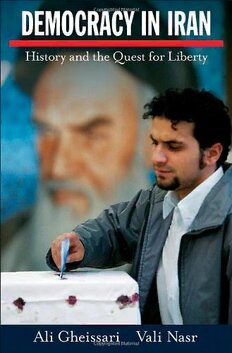
Democracy in Iran: History and the Quest for Liberty PDF
Preview Democracy in Iran: History and the Quest for Liberty
Democracy in Iran TThhiiss ppaaggee iinntteennttiioonnaallllyy lleefftt bbllaannkk Democracy in Iran History and the Quest for Liberty ali gheissari vali nasr 1 2006 1 OxfordUniversityPress,Inc.,publishesworksthatfurther OxfordUniversity’sobjectiveofexcellence inresearch,scholarship,andeducation. Oxford NewYork Auckland CapeTown DaresSalaam HongKong Karachi KualaLumpur Madrid Melbourne MexicoCity Nairobi NewDelhi Shanghai Taipei Toronto Withofficesin Argentina Austria Brazil Chile CzechRepublic France Greece Guatemala Hungary Italy Japan Poland Portugal Singapore SouthKorea Switzerland Thailand Turkey Ukraine Vietnam Copyright(cid:1)2006byOxfordUniversityPress,Inc. PublishedbyOxfordUniversityPress,Inc. 198MadisonAvenue,NewYork,NewYork10016 www.oup.com OxfordisaregisteredtrademarkofOxfordUniversityPress Allrightsreserved.Nopartofthispublicationmaybereproduced, storedinaretrievalsystem,ortransmitted,inanyformorbyanymeans, electronic,mechanical,photocopying,recording,orotherwise, withoutthepriorpermissionofOxfordUniversityPress. LibraryofCongressCataloging-in-PublicationData Gheissari,Ali,1954– DemocracyinIran:historyandthequestforliberty/AliGheissari,ValiNasr. p. cm. Includesbibliographicalreferencesandindex. ISBN-13978-0-19-518967-4 ISBN0-19-518967-1 1. Iran—Politicsandgovernment—20thcentury. 2. Democracy—Iran. I. Nasr,SeyyedValiReza,1960– II. Title. DS316.6.G472006 955.05—dc22 2005031799 9 8 7 6 5 4 3 2 1 PrintedintheUnitedStatesofAmerica onacid-freepaper Preface InJune2005,Iranianswenttothepollstoelectanewpresident.This wastheninthpresidentialelectionandthirty-seventhnationalelec- tionsinceIran’s1979revolution.Theintenselycontestedracealso markedthethirdtransitionofthepresidencyinthepost-Khomeini periodandtheelectionofthefirstnonclericalpresidentsince1981. Overthecourseofthepasttwenty-fiveyearselectionshavebecome increasinglyimportanttodistributionofpowerinIranianpolitics.Al- thoughthemostimportantleaderofthecountry,theSupreme Leader,isunelectedandisnotsubjecttochecksandbalancesofa democraticorder,votingstilldecidesthedirectionofpopularpolitical debatesandinfluencespolicymaking.Italsoaffectsdistributionof powerandpoliticalofficesatthenationallevelandincreasinglysoat thelocallevelaswell.Electionsnowinfluencedistributionofre- sourcesamongvariousprovincesontheonehand,andurbanand ruralareasontheother.Theydecidetherelativepowerofvariousso- cialgroupsandpoliticalforces;bothreflectanddeterminethescope ofpolitical,cultural,andeconomicdebatesinthecountry. Iranhasbeenanimprobablecandidateforthefloweringofde- mocracy.The1979revolutioncreatedtheonlyIslamicstatetoresult fromasuccessfulIslamicfundamentalistdriveforpower.Revolution- aryzealandIslamicideologywerehostiletodemocracyandlooked toanall-powerfulstatethatwouldreflectrevolutionaryvaluesasthe embodimentandguarantorofanidealizedIslamicorder.Still,in manyregardsthereismoreprogresstowarddemocracyinIranthan vi preface in any other country in the Middle East, perhaps with the exception of Turkey. Over the course of the past two and a half decades Iranians have embraced democratic practices, participatedin electionsatlocalandnationallevels,and believedthattheirvoteaffectspoliticaloutcomes.Iraniansbegintovoteatthe ageoffifteen,andanentiregenerationhasnowbeenschooledintherudiments ofvotingandelectioneering,inthegive-and-takeofpromisesbypoliticiansand votes by their constituents, andabove allin boththe loftyidealsofdemocracy and the more mundane mechanics of democratic practice.TheIranianconsti- tution vests sovereignty in God, but Iranian politicians look to the people for theirmandate.Allthishasproducednotademocraticstatebutacitizenrythat understands the fundamental logic of democracy and the laws that govern its practice. Iranians do not live in a democracy, buttheir politicsareincreasingly informedandinfluencedbyitsfoundationallogic. DemocracyinIranwasnotthedeclaredgoaloftheIslamicRevolutionbut was an unintended consequence of its unfolding. As the new president, Mah- moud Ahmadinejad,saidon his campaign trail, “Wedidnothavea revolution in order to have democracy.”1 However, to be president, he had to win the election. Democracy in Iran was neither a project of the state nor importedas an ideal form of politics from the West and implemented from above,buthas ratheremergedasagrassrootsphenomenon,sothatdemocraticthinkingand politicalexpectationsareprevalentinsocietyandnowserveasthemainimpetus forcontinuedstruggletowarddemocraticchange.Thechallengefacingdemoc- ratizationindevelopingcountriesisthatpoliticalreformsfromaboveoftendo not grow roots because the society has not embraced democratic values and practice. Democratic politics cannot take hold where the political culture has not internalized both the values and the practical components of democracy, and where the attitude of the people toward authority does not reflect such values and commitments. In Iran, conversely, it is the democraticattitudesinsociety rather than reforms from above that account for progress toward democracy. This is an important development that setsIran apartfrom itsMiddleEastern neighbors. Although state behavior in Iran does not normatively reflectdemo- cratic values, in many regards Iranian society has already turned the corner, passingthroughamorechallengingthresholdofdemocratization,byadopting thedemocraticethosatthegrassrootslevelandlookingtocivilsocietyactivism and elections to voice social and political demands. It is this fact that makes IranthemorelikelycandidateforveritabledemocracyintheMiddleEast,despite the country’s theocratic edifice and authoritarian power structure. How an Is- lamic state in Iran has moved farther along the path of democracy than many secularstatesintheMiddleEastraisesimportantquestions. preface vii The seeming paradox of the Iranian case has to do with the complexityof Iran’sstrugglewithdemocracy,onethatspansacenturyandthatinvolvesbroad questionsofstate-building,socialdevelopment,culturalchange,andindividual freedoms. Although the struggle for democracy has gained momentum in the pastdecade,itsrootsrundeepincontemporaryIranianhistory.The2005pres- idential election elucidates this point as it encompasses not only the current struggleforpoliticalandculturalfreedomsbutalsohistoricaldebatesoverstate- society relations and the desired path to development. Two issuesdominated theelection.First,thedemandforpoliticalreformandculturalopening,which meansempoweringthesocietyandreducingstatepower.Second,thedemand forthestatetosolvesocioeconomicproblems,whichmeansstrengtheningstate institutionsandextendingthepurviewoftheirdecisionmaking.Theelectionin awayhighlightedthefundamentalproblemofdemocratization,howtomaintain balanceinstate-societyrelationstobothfosterdemocracyandenablethestate toaddresssocialdemands.Thisproblemhasbeenattheheartofstate-building andthequestfordemocracyoverthecourseofthepastcentury.HowIranhas responded to this challenge, and how it will continue to do so from this point forwardisinstructiveforthestudyofdemocratization.ThechallengefacingIran today, as it was a century ago when the country promulgateditsfirstconstitu- tion, is how to bring together the quest for democracy and the imperatives of state-building to create a democratic state. This book chronicles how Iran has contendedwiththischallenge,andwhatthelegacyofthateffortmeansforour understandingofdemocracyanditsmanifestationintheMuslimworld. ThisbookisnotacomprehensivepoliticalhistoryofmodernIran,although it does rely on historical facts and analysis. It is conceived in considerationof Iran’s struggle to become a democratic state, and therefore focuses on those themesthathighlightthatstruggleanditsoutcome.Themainthreadthatruns through the analytical narrative is how Iran has responded to the challengeof balancing state-building with democracy-building. This approach allows us to look at Iran’s historical experience over the course of the past century from a very different angle, bringing new perspective to analyzing and understanding thevicissitudesofcontinuityandchange,successandfailures,andtheunique path to both state-building and democracy-building that has emerged in Iran. The result is a new approach for understanding state-society relations in Iran over the expanse of the country’s modern history, one that seeks to highlight overarching themes and long-term trends that will allow us to organize facts around a framework of analysis that goes beyond mere chronology of events. Theideaofthisbookgrewoutofcontinueddiscussionsthatwehavehadover the nature of state and society in Iran, the role of religion in politics, and the contestbetweenideologyanddemocracyinmodernIranianhistory. viii preface Manyoftheissuesraisedinthisbookwerepresentedatacademicseminars at Tehran University, Harvard University, UCLA, Georgetown University, MIT, and Oxford University. We are grateful for comments by colleagues on those occasions. We are further grateful to Ervand Abrahamian, Kaveh Ehsani, Ali Moazzami, and Ali Rahnema for their comments. We would also like to thank Cynthia Read and Theo Calderara, our editors at Oxford University Press, for their interest in this book, Christine Dahlin, Karla Pace, and Julia TerMaat for assistance with the book’s production, and Norma McLemore for copyediting thetext. We have avoided most diacritical marks and have used a more phonetic pattern closer to the current Persian pronunciation. Established words and namesinEnglishareAnglicized.Alltranslationsarebytheauthorsunlessoth- erwisestated.Thereferencesinthisbookprovidesourcesforobservationsand factsbutalsodirectthereadertootherrelevantworksonthetopic.Inaddition, in this book we use terms such as fundamentalism, theocracy, or cleric in the manner in which they are used commonly in both academia and the media. Although there has been extensive debate over the use of the term fundamen- talism, it has now gained sufficient currency—especially sincetheliteraltrans- lation of the word as Osoulgarai (and Bonyadgarai) is widely used in Persian, especiallybythosetowhomthetermactuallyrefers.Similarly,weusetheterms clericandtheocracyinthemannerinwhichtheyarewidelyusedtodescribethe roleoftheulamainIranianpolitics. Contents Chronology,xi Introduction,3 PART I: RISE OF THE STATE 1 Democracy or State-Building? 1906–1941, 23 2 TheTriumphoftheState,1941–1979,45 PART II: THE CRUCIBLE OF THE REVOLUTION 3 Revolution and War Fundamentalism, 1979–1989, 77 4 AnIslamicDevelopmentalState?1989–1997,105 5 StateandLimitstoDemocracy,1997–2005,127 6 Epilogue ProspectsforaDemocraticState,147 Notes,159 Bibliography,185 Index,207
